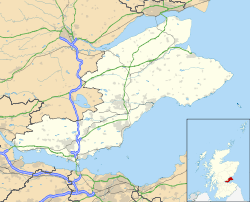Auchtermuchty
| Auchtermuchty | |
| Scottish Gaelic: Uachdar Mucadaidh | |
| Scots: Auchtermuchtie, Muchtie | |
 Auchtermuchty |
|
| Population | 2,093 [1] (2011 census) |
|---|---|
| OS grid reference | NO235115 |
| Council area | Fife |
| Lieutenancy area | Fife |
| Country | Scotland |
| Sovereign state | United Kingdom |
| Post town | CUPAR |
| Postcode district | KY14 |
| Dialling code | 01337 |
| Police | Scottish |
| Fire | Scottish |
| Ambulance | Scottish |
| EU Parliament | Scotland |
| UK Parliament | North East Fife |
| Scottish Parliament | North East Fife |
Coordinates: 56°17′23″N 3°14′15″W / 56.289754°N 3.237450°W
Auchtermuchty (/ˌɒxtərˈmʌxti/ ![]() listen ; Gaelic: Uachdar Mucadaidh, "upland of the pigs/boar")[2] is a town in Fife, Scotland. It is beside Pitlour Hill and nine miles north of Glenrothes.
listen ; Gaelic: Uachdar Mucadaidh, "upland of the pigs/boar")[2] is a town in Fife, Scotland. It is beside Pitlour Hill and nine miles north of Glenrothes.
History
Until 1975 Auchtermuchty was a royal burgh, established under charter of King James V in 1517. There is evidence of human habitation in the area dating back over 2,000 years, and the Romans are known to have established a camp in the southeast corner of the town. In the past, the linen industry was a major source of work in the town, but in the early 18th century the firm of John White was established, bringing the town its first foundry (there were two eventually). There was even a distillery in operation from 1829 to 1929, when Prohibition in the U.S.A. led to its closure. The town nowadays is a quiet but thriving community, situated in the Scottish countryside, where there are several local recreational footpaths. There is a modest range of local industry, but most people of working age travel out of the town for employment.
There is a festival held each year in August.
Buildings
The old part of the town is based around a hill. The twisting streets here have a wealth of buildings dating from the 17th and 18th century, centred on a medieval peel tower (now forming part of the town library).
The church (on the east side of the hill) is a simple Georgian box chapel, but with an interesting double bell within its western bellcote. Gravestones date back to the 17th century. A more modern cemetery lies to the south-east of the town, partly concealed by industrial units. This dates from around 1910.
The town war memorial is of note, and is an unusual design by the architect Reginald Fairlie.
Trivia
Auchtermuchty was the setting for The Wife of Auchtermuchty, a comic Scots poem of the late Middle Ages.
The town was used as the location for Tannochbrae in the 1990s ITV series Dr. Finlay.
The town's church is mentioned in James Hogg's The Private Memoirs and Confessions of a Justified Sinner.
The town gets a mention in The Family Ness theme song, You'll Never Find A Nessie In The Zoo, in the refrain "You can go to Auchtermuchty and to Drumnadrochit too, but you'll never find a Nessie in the zoo". The town, which is on the main road to the world famous golf courses at St. Andrews, was frequently mentioned in a light-hearted manner by the journalist Sir John Junor, as a paradigm of British ordinariness, but although he was a frequent visitor, he did not come from or live there.[3] The town is also mentioned in the 1999 "Wear the Fox Hat" commercial for Miller Beer .
Auchtermuchty Golf Club (now defunct) was founded in 1902. The club ceased to exist following WW2.[4]
Auchtermuchty was often referred to by John Junor in the Daily Express: "John Junor's editorial approach was simple: articulate the fears and preoccupations of Middle England and liven them up with dollops of hokey Scottish folk wisdom. In his column for the paper, Junor lit upon the small Scottish town of Auchtermuchty and made it into his own personal Brigadoon, a place of solemn courtesy to one's betters and implacable hostility to outsiders." [5]
Notable people

- John Glas - founder of the Glasite religious sect
- Charlie and Craig Reid - musicians and founders of folk/rock group The Proclaimers
- Martin Stewart - Bad Manners keyboard player
- Sir Jimmy Shand - musician
- Sir John Arnott, MP and founder of Arnotts department stores in Dublin and elsewhere
- Captain George Moodie, the first captain of the Cutty Sark who oversaw the building of her in 1869 and served as her Captain until 1872, lived his final years in Auchtermuchty in MacDuff House on the High Street.
- James Campbell Walker - architect
See also
References
- ↑ http://www.scotlandscensus.gov.uk/ods-web/home.html
- ↑ Gaelic Placenames collected by Iain Mac an Tailleir (2003)
- ↑ Obituary in the Independent
- ↑ "Auchtermuchty Golf Club", "Golf’s Missing Links".
- ↑ "Mr Angry of Auchtermuchty", "Mr Angry of Auchtermuchty".